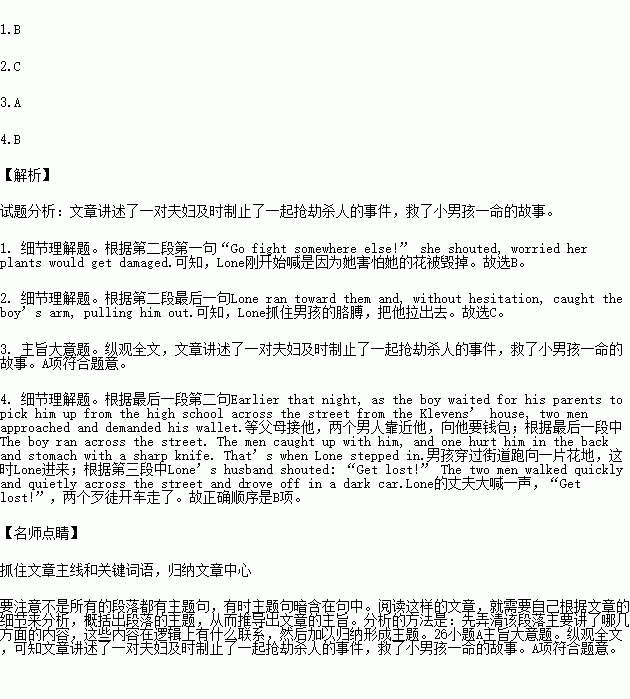题目内容
On a Friday night in May 2015, Oliver and Lone Kleven heard angry shouts coming from their front lawn. Lone, 68, stepped onto the porch and saw two men in dark clothes struggling with something on the ground—right where she and her grandson had planted a flower bed the weekend before.
“Go fight somewhere else!” she shouted, worried her plants would get damaged. At the sound of her voice, the face of a boy appeared from beneath the two men. He looked 13 or 14 or so. “They’re trying to kill me!” the boy screamed. Lone ran toward them and, without hesitation, caught the boy’s arm, pulling him out.
“Leave him alone!” she shouted. When the men stood up, Lone saw what looked like a sharp object in one man’s hand. When she turned back toward the boy, he was moaning in pain and holding his stomach. The attackers began to move in on the boy again when Lone’s husband shouted: “Get lost!” The two men walked quickly and quietly across the street and drove off in a dark car.
“I have to get to the hospital!” the boy cried. He lifted his shirt, and Lone could see a bloody wound on his stomach. Oliver hugged the trembling boy while Lone caught her cell phone and car keys inside the house. She handed the phone to Oliver. “Call 911,” she told him. “I’m going after them.” Lone took off but was unable to find the car.
The Klevens then learned what had happened. Earlier that night, as the boy waited for his parents to pick him up from the high school across the street from the Klevens’ house, two men approached and demanded his wallet. When he refused, one of the men hit him in the face. The boy ran across the street. The men caught up with him, and one hurt him in the back and stomach with a sharp knife. That’s when Lone stepped in.
The boy’s wounds required operations, but he has fully recovered.
“He was alone and outnumbered,” says Lone. “There was no time to do anything except what I did.”
1.Why did Lone shout at the man at the beginning of the story?
A. To stop them fighting with each other.
B. To prevent her flowers being ruined.
C. To stop them stealing in the flower bed.
D. To keep the boy from being wounded.
2.What’s Lone’s first reaction when she got close to the men?
A. She kept them separate.
B. She was shocked at the boy’s wounds.
C. She pulled the boy out.
D. She called her husband for help.
3.What’s the main idea of the passage?
A. An old couple rescued a boy by fighting against two robbers.
B. A boy was saved.
C. Two robbers were driven away.
D. An old lady didn’t track the two robbers.
4.What’s the correct order of the following events?
a. Lone stepped in the fight.
b. The two men drove off in a dark car.
c. The boy waited for his parents to pick him up.
d. Lone’s husband boomed from the porch.
e. Two men approached and demanded the boy’s wallet.
f. The boy ran across the street to a flower bed.
A. cfeadbB. cefadbC. fecabdD. eafcbd
 名校课堂系列答案
名校课堂系列答案
